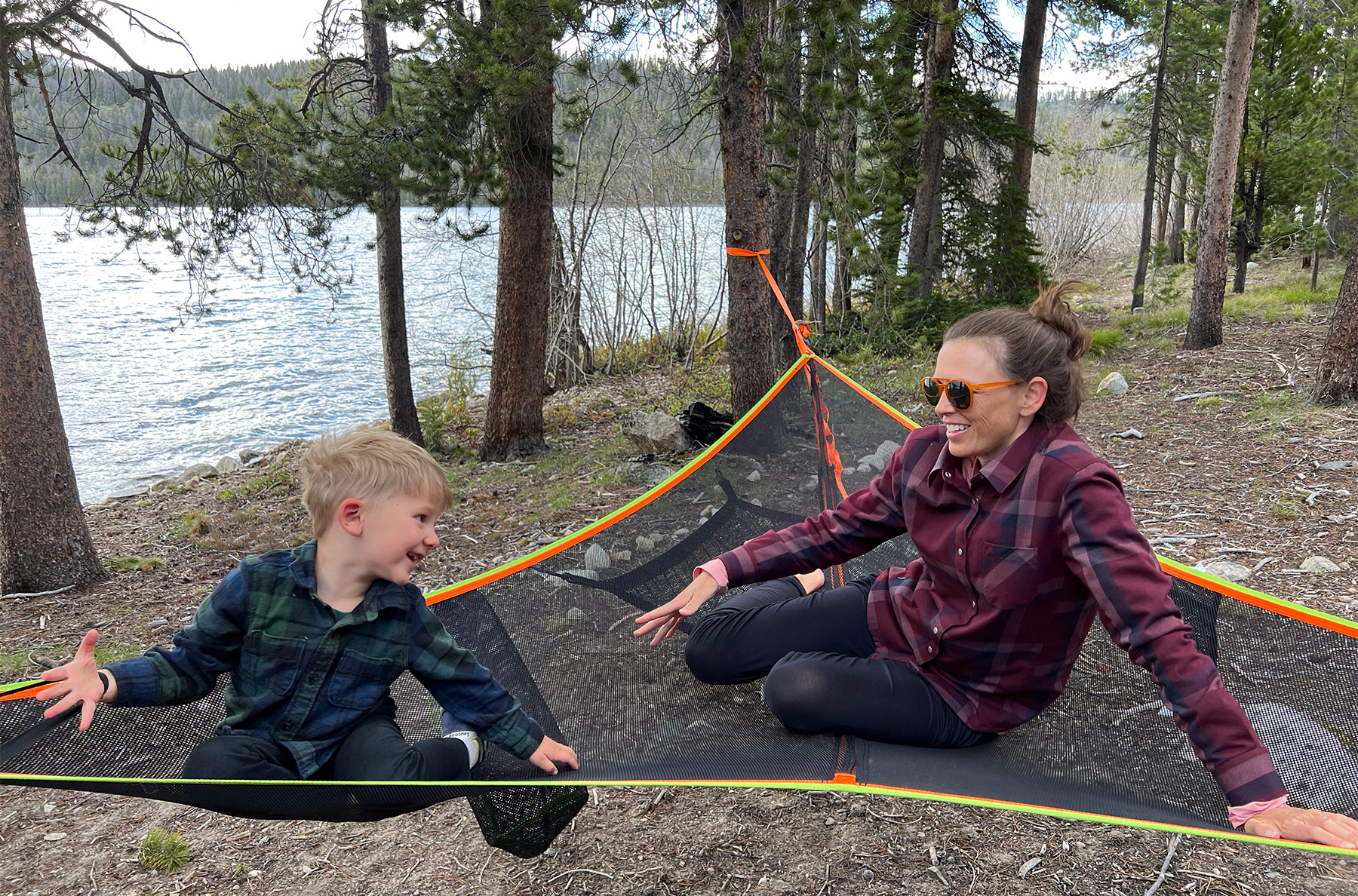
Intro
Most of our reviews are pretty long — and take a long time to produce — because we want to provide enough info for you to actually determine whether the gear we tested will work well for you.
But we get asked to check out an increasingly wide range of products, and sometimes, we just want to tell you about something we’ve been using and loving lately.
So that’s where this monthly series — Stuff We Like — comes in, where we keep you current on a broad range of stuff we’re currently digging.
And if there’s something you love that you think we ought to check out, drop us a note in the comment section below.
Katadyn BeFree Water Filtration System 0.6L
MSRP: $44.95
Drew Kelly: Water is heavy and takes up a lot of space in a pack. The running vest I use for most of my summer activities has a capacity of 12 liters, and using 4 of those liters to carry water leaves me little room to fit everything else I need for a big day. That’s where the Katadyn BeFree filter comes in.
At 59 grams, the Katadyn BeFree filter is something I’ll pack if I’m unsure of viable water sources, and given that it’s small enough to stuff into any pocket when empty, there’s never really a good excuse to leave it at home.
I’ve found many other water filters to be quite frustrating to operate: iodine treatment tastes bad and requires a 20 minute waiting period; using straw filters often means awkwardly sucking at a puddle; and pump systems are almost always large and slow, with many parts that can fail or go missing. But the BeFree filter works like a simple squeezable water bottle: dip in water source to fill, screw on cap, and squeeze into mouth. It flows just about as fast as a regular water bottle too.
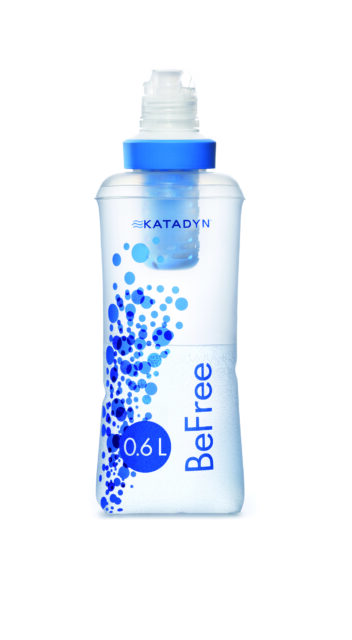
The actual filter used in the BeFree meets the same standards as other portable microfiber filters on the market. Katadyn claims their BeFree can purify 1000 liters of water in its lifespan (though mine usually starts to slow down around 400 liters, so make sure to check yours routinely).
Some things to be aware of: The Katadyn BeFree filter does not neutralize viruses and works best after its microfibers have been wetted through a few times. The filter also comes in multiple sizes, though I recommend the 0.6 liter version because it fits nicely in a running vest’s chest pocket and can quickly fill your soft flask bottles.
Katadyn Steripen Ultra UV Water Purifier
MSRP: $130
Dylan Wood: Like Drew, I don’t want to carry extra weight if I don’t have to, and water is definitely heavy. While dehydrating your food can lighten your load, you obviously can’t do that with water, so there’s really no way of getting around the bulk it will add to your pack. It also feels silly to carry water around when we are riding next to creeks or through at least a couple stream crossings on almost every ride in Crested Butte.
Because of this, I’ve been carrying around a Katadyn Steripen Ultra UV Water Purifier on almost all of my rides. It weighs 140 grams and is about as big as a small hand pump, so while it isn’t the smallest or lightest option out there, it is still reasonable to have around (Katadyn makes smaller versions of the Steripen, too).
The Steripen uses Ultraviolet light to treat water. Essentially, the UV light alters the DNA of whatever organisms are in the water, preventing them from reproducing inside you and making you sick. The Steripen has settings to treat 1 liter or a half-liter of water at a time, and takes 90 or 48 seconds to do so, respectively. The water bottle I use is 24 ounces, so I will use the 1 liter setting most of the time, but I do have a mark on my bottle where a ½ liter is so I can treat water in less time if I want.
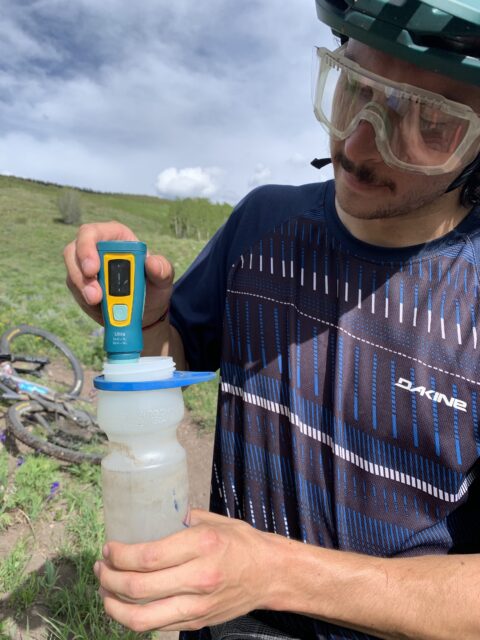
I really like that the Steripen doesn’t add to or take anything away from the water, preserving the taste of cold, fresh, mountain streams. Conversely, this does mean that the Steripen is only effective in clear water. Speaking of effectiveness, Steripen is certified to be 99.9% effective against viruses, bacteria, and protozoa, making it one of the most reliable options on the market. I have yet to get sick while using it and I’ve drank out of some questionable water sources (a clear pond popular with cows was one of the first I tried). The Steripen is rechargeable via micro-USB and should be good for around 50 treatments per charge. Unlike other membrane-based filters, it doesn’t need cleaning or maintenance, and Steripen will send you a free replacement UV Bulb if you surpass the 8,000 treatments it’s rated for.
Outdoor enthusiasts looking for a water treatment system should definitely consider getting a Steripen, especially if you don’t like the taste (or lack of taste) that other water treatment systems create.
Jed Doane: I’ll echo Dylan here. I used Katadyn’s Ultralight for several weeks in Nepal drinking from a wide variety of dubious sources without incident, and my filter would often go for a week or more without needing a charge. It’s a great choice for ultralight water purification and keeping water weight down, especially if you’re familiar with water sources along your route.
SheFly Go There Pant
MSRP: $168
Size Tested: 8
Kara Williard: It’s becoming less of a taboo topic, but it’s really not that easy to pee in the outdoors as a woman. Sure, when conditions are right and you are either solo or in complete privacy, it isn’t that hard, but I’ve found that seldom to be the case. When I’m outside guiding or farming, finding the right location to completely pull my pants down has taken long enough to where I’ve nearly peed in them. This is especially tricky in the middle of a barren desert or with a climbing harness on. So, do I believe that SheFly has taken on an issue that is pretty essential to the comfort of women in outdoor spaces? Absolutely.

For those that don’t know, SheFly pants are designed with both a regular crotch zipper and a patented second zipper, which extends below the regular fly to the back of the pants. So yeah, just like all the men out there, I can just unzip and pee. As far as this unique design goes, I have come to LOVE it. The only downside is that these awesome zippers aren’t built into every type of athletic clothing I own. The zipper itself works extremely well and is much easier to manage than I initially assumed it would be. It’s also quite comfortable; the pants don’t feel at all as though there is a zipper running the length of the crotch seam. As far as zipper design goes, these pants are extremely well done.
Aside from the functionality of the zipper, the Go There Pant is just a really well-designed and comfortable pant. It is built with 4-way stretch fabric (93% nylon, 7% spandex), features five large pockets, and has a really comfortable waistband with waist ties for additional cinching. Lastly, the Go There Pant is also darn cute and fits and looks way better than I could have imagined. It has easily become one of my favorite pants just for wearing around town. I was surprised that it’s nearly impossible to notice the zipper, and I found the fit to be flattering, comfortable, and offer plenty of mobility. A size 8 worked great for me, which is my usual size, so I feel confident in recommending that people stick to their common size. I know that the Go There Pant is on pre-order and arriving in mid-July, so for any woman who has struggled with: (1) finding a good solution for comfortable and less vulnerable outdoor peeing, or (2) just needs a really good pair of pants for hiking, climbing, camping, or daily use, the Go There Pant is super well done, and I absolutely recommend it.
Tentsile T-Mini 2-Person Double Camping Hammock (3.0)
MSRP: $189 (currently on sale for $151)
Kristin Sinnott: I am currently on a 3-week roadtrip with my family and the T-Mini 2-Person Double Camping Hammock is one of the best items I packed. The entire hammock fits inside a mesh bag that’s attached to it, making packing easy. We haven’t gotten to use it every day, but whenever I get an opportunity to set it up, I do so. It only takes about 5 minutes to set up, but I do recommend watching a video tutorial before your first attempt. Tentsile’s hammock makes lounging around anywhere, including campsites, much more comfortable. And if you have a kid, it makes everything from storytime to snack time a bit more exciting.
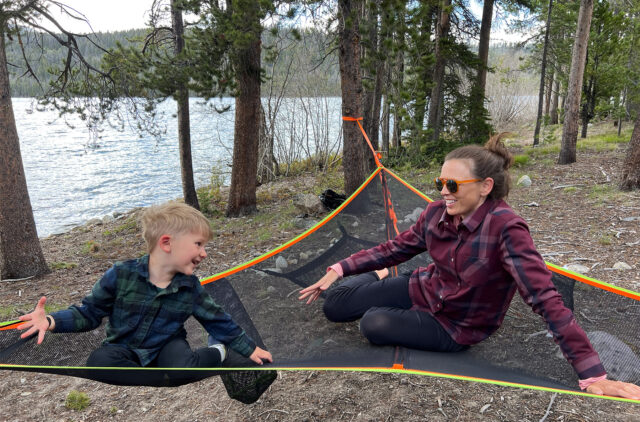
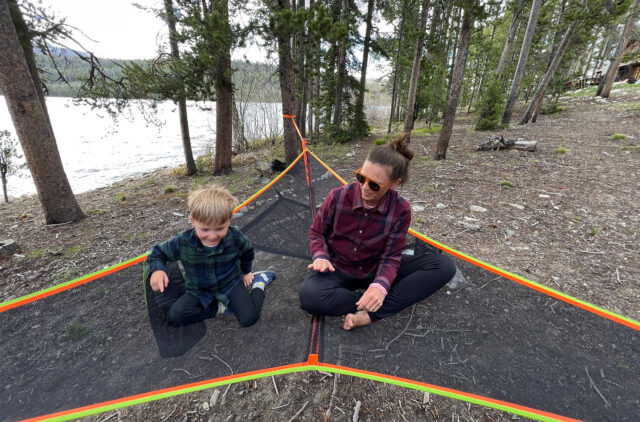
I have Tentsile’s mesh version and it is far superior (i.e., more comfortable) than a traditional rope hammock. It’s also breathable, which is nice for warm days, but it can be a little chilly for lounging in cold weather. Fortunately, laying on a blanket easily solves that problem. And if you’re looking for a camping blanket, I highly recommend checking out the Kuhl Spyfire Down Komforter and the Voited Cloudtouch Indoor/Outdoor Camping Blanket. I’ll write more about them in a future “Stuff We Like,” but for now I’ll just say we use both blankets frequently.
Rocker Ski Rack – Mountains
MSRP: $269
Dylan Wood: I just moved into a new apartment with my partner and it feels great to finally have a new space that is clean, organized, and spacious (for reference, I was living in a small 3 bedroom unit with 4 people beforehand… #mountaintownthings).
Before moving in, I knew that I wanted a ski storage solution for the apartment. In the past, my roommates and I had just leaned our skis and boards against a wall that had a plank with pegs sticking out, and while that setup was fine, it was disorganized. Skis would sometimes fall over, or get buried behind other people’s skis and boards. My partner also had a ski rack that was similar, but the pegs were very close together, and the system relied on hanging the skis between the pegs, with the rockered portions holding the skis in place and preventing them from sliding off the rack. This system puts a lot of stress on your ski’s rockered tips and has the potential to alter their rocker profile over time. I’ve seen racks like this in a lot of people’s houses and apartments, and every time it bothers me to know that they might be damaging their equipment without even knowing it.
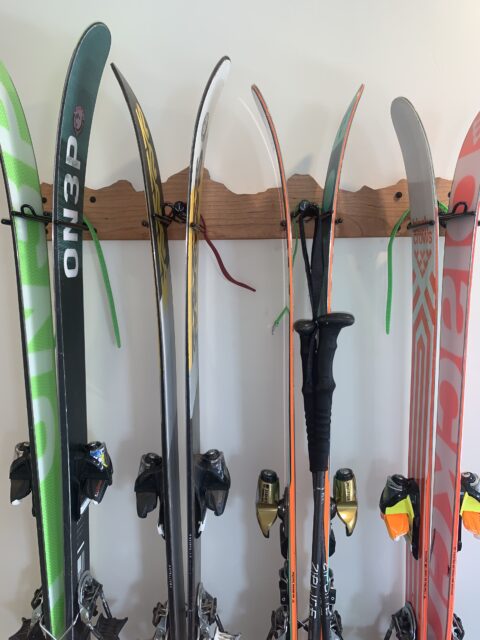
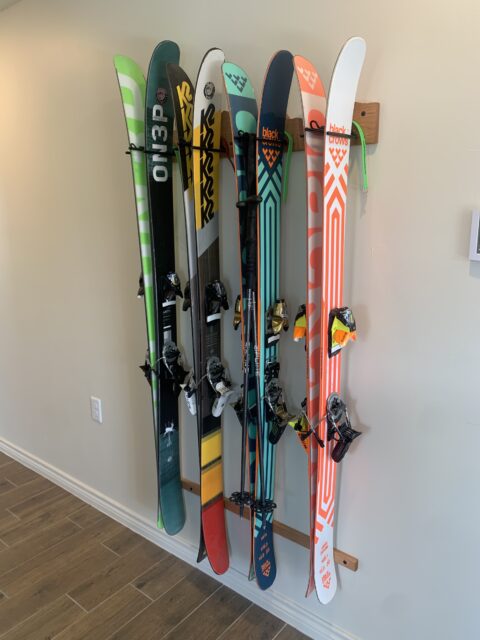
When I came across the Rocker Ski Rack, I knew I wanted to try their product. Their racks essentially use arms that rely on friction to hold your skis / snowboard in place above the ground without altering their rocker profiles. They make several different models, from an individual set of arms to a six-pack of them held together by a hardwood backing. I opted for a four-pack of racks with their “Mountains” backing for a little extra stylistic flare. I also got a “tail bumper,” which protects your wall from your skis’ tails banging against it and causing damage.
Mounting was pretty straightforward, apart from the fact that the included wood screws use a square #2 drill bit, which I have never used and didn’t own (Rocker Ski Rack can send you one if you don’t have one). Once mounted, inserting your skis is more complicated than just setting them against a wall, but it doesn’t take more than 20 seconds. The arms pivot on the rack, and by lifting them up with your ski / snowboard and then allowing them to fall back into place, the Rocker Ski Rack “locks” your gear in a fixed position (check out this video if you’re a visual learner). This rack can also hold your poles, so long as you have pole straps on them.
Overall, I’m really happy with this ski rack. Not only do I not have to worry about knocking my skis over, but it’s also good to be able to store my partner’s and my skis without damaging their rocker profiles. It looks really nice in my apartment, and I also like that it shows off your ski’s base graphics. Skiers / snowboarders who like an orderly living space and want to take care of their equipment could definitely benefit from having one of these on their wall.
Renthal Fatbar V2
MSRP: $110.45
David Golay: I’m pretty picky about a lot of things having to do with bike setup, but handlebars might be the part that I’m the most unusually picky about. So, when I say that the 31.8 mm diameter aluminum version of the Renthal Fatbar V2 handlebar is my hands-down favorite, I mean it.
I’ve already complained in detail about the whole concept of 35 mm handlebars, especially carbon ones. Even in the smaller 31.8 mm diameter, I still prefer aluminum handlebars for ride quality, price, and durability reasons — breaking a handlebar is not a good time, and while it’s admittedly rare with modern high-end carbon options, I’ve still seen way more of them break catastrophically than aluminum ones.
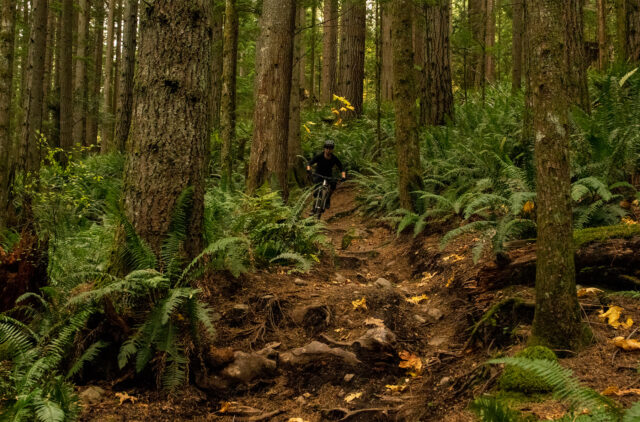
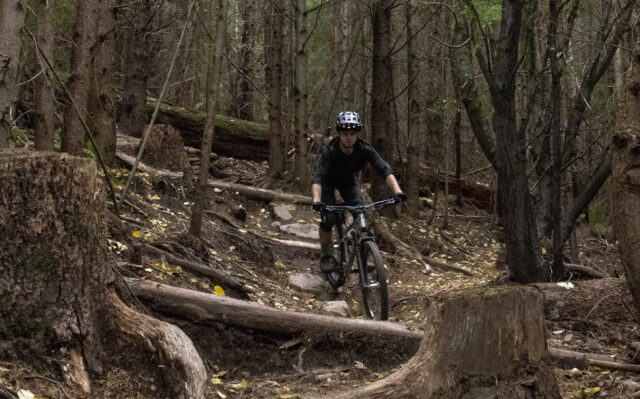
Back to the Renthal: the original aluminum Fatbar was overbuilt, heavy, and brutally stiff, but the V2 version is vastly more refined and rides really nicely. It’s also got a bit less sweep than most, at 7° back and 5° up, which works better for my wrists and shoulders. The Renthal is available in a huge range of rise options (0 to 40 mm in 10 mm increments), and can be had in black, too.
That’s all my boxes checked. There are also carbon and/or 35 mm clamp versions if you really insist on going that route, but in my mind the 31.8 mm aluminum one is the way to go.
Giro Latch Shoe
MSRP: $150
Luke Koppa: I’m not typically someone that frequently misplaces things, but this spring, I have been losing my mind trying to track down about half of my bike gear, which apparently disappeared sometime between last fall and now. I’ve hounded down most of my pedals, my helmet, and sunglasses, but I have yet to find any of my go-to shoes.
Fortunately, this coincided with receiving Giro’s new flat-pedal shoe, the Latch. Now, I’m pretty picky about flat-pedal shoes, with my main concern being how much grip they offer on the pedals. The Ride Concepts Powerline was, until this year, the only non-Five-Ten shoe I had used that offered a sufficiently tacky sole for my preferences. I can now add the Giro Latch to that short list.
The Latch’s “Tack Rubber” compound and shallow “Gamma Tread” still don’t equate to quite as much grip as the Stealth rubber on the Five Ten Sleuth DLX, but it’s not wildly far off. I’d say the Latch’s rubber is quite similar to the Ride Concepts’ “Max Grip” rubber compound in terms of tackiness, with Max Grip maybe winning by a hair.
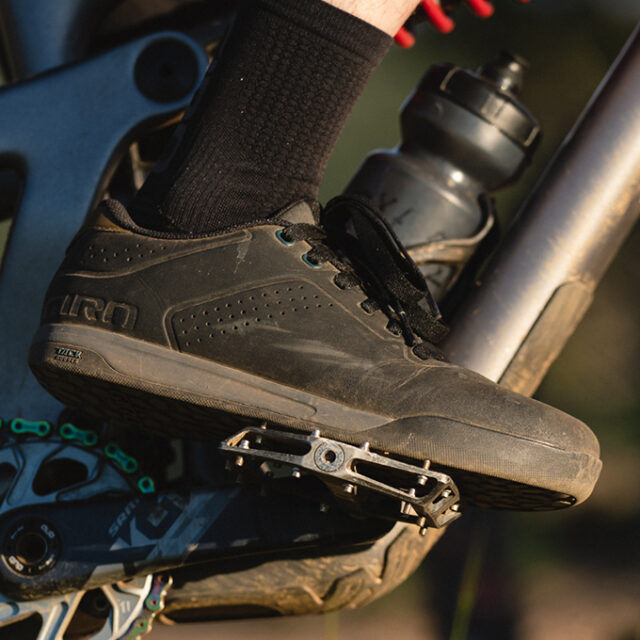
The main point is that, unlike most other flat-pedal shoes I’ve used, I haven’t found myself frequently wishing for a more planted, stable grip on the pedals when wearing the Latch. And on particularly grippy pedals like the big, concave Deity Deftrap, I actually find Five Ten’s Stealth rubber to be a bit too grippy, making it difficult to reposition my feet, so I actually prefer the Latch in that scenario.
Rubber aside, the Latch has so far proven to be a pretty versatile Trail shoe. It’s not super breathable, but its microfiber upper has done a great job of shrugging off rocks and trees (I’m optimistic about its long-term durability). My only real gripe so far is that the heel hold, on my feet at least, could be a bit better. Its heel cup isn’t very deep and my heel lifts a bit while walking, but I’ve never noticed any movement while actually on the bike. All in all, I’ve enjoyed the Latch as an all-round flat shoe and I think it competes well with the other go-to options on the market.
Free Fly W’s Bamboo Shade Hoody
MSRP: $68
Size Tested: Medium
Kara Williard: I am attempting to be really diligent about sun protection this summer. I don’t get sunburned, so finding motivation to take precautions can be hard. I also dislike the stifling feeling of wearing more clothes soley for sun protection. However, I received the Free Fly W’s Bamboo Shade Hoody as a gift this winter, and I first used it several times skiing this spring for lightweight, wicking sun protection. It worked great for skiing on warmer days, and I liked the impressive coverage the hood provided. It has since become my favorite shirt for summer sun protection.
The bamboo material is both breathable and incredibly soft. It is seriously one of the softest shirts I have ever owned. I will admit, bamboo is not the best wicking material when I am sweating profusely because it behaves more like cotton, which is not excellent for wicking. Like cotton, the bamboo material also stays damp longer than my wool or synthetic baselayers. This has a helpful cooling effect, but can be a borderline problem when temperatures shift and a sudden cool breeze leaves me feeling chilly.
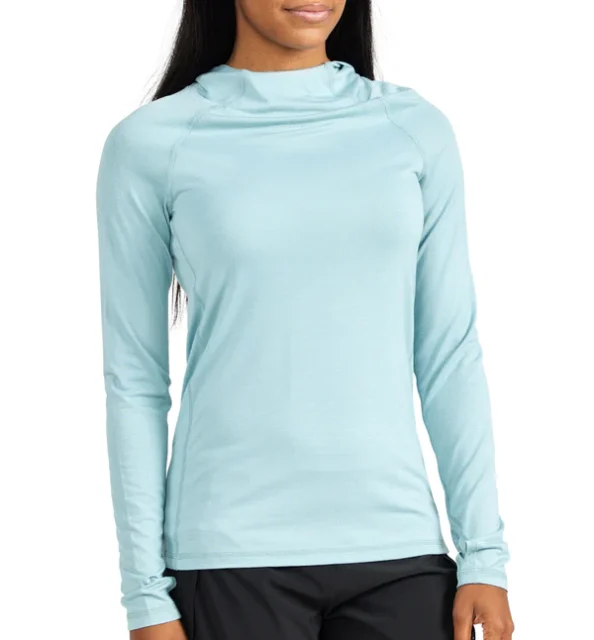
However, for many of the hot summer activities I have been undertaking lately — especially working outside on the farm and planting trees — this has been an awesome material for staying cool while also providing sun protection that doesn’t feel excessive. This is a go-to shirt for many summer adventures including climbing, hiking, farming, and camping. A women’s size medium works well for me (for reference, I am 5’9”, 167 lbs / 175 cm, 75.7 kg), even with layers beneath, and the sleeves are plenty long too. For someone looking for a baggier fit, sizing up should do the trick.
Kristin Sinnott: I’ve been wearing the W’s Bamboo Shade Hoody for the past 3 years and I still love it. I wrote about it in a roundup back in 2019. It’s buttery soft and extremely comfortable. At 5’8”,173 cm / 125 lbs, 57 kg, I wear a women’s size medium and I find it to be plenty long enough in the arms and torso and the fit is slightly relaxed but not baggy.
Carve Designs Stargazer Shorts
MSRP: $59
Kristin Sinnott: I’ve always been a fan of hiking destinations that end in a swimming hole or have options for quick dips along the trail. When I was younger, I was fine jumping in in my underwear, but as I’ve gotten older (and I guess a bit more modest), I tend to choose something that resembles a swimsuit. So, over the past few years I’ve started wearing swim shorts that work for hiking and swimming. Whether it’s wandering down to a river or hot spring, I like having the option to just go in the water without changing and then being able to hike out in whatever I’m wearing.
The Stargazer Shorts are a fairly recent addition to Carve Designs lineup and I’ve found them to work well as multi-use shorts. They don’t dry as quickly as standard bikini bottoms, mainly because they have more material, but they provide more coverage and are much more comfortable to hike in than a wet bikini bottom under a pair of shorts. I have a size small (I’m 5’8”, 125 lbs) and they fit well but don’t run too tight. For a snugger fit, I think I could have gone with an extra small. The nylon / spandex fabric is the same blend Carve Designs uses for their swimsuits, and the internal liner is slightly grippy around the seams to keep the bottoms in place. And, 100% of Carve Designs swim collection is made from “sustainable fabric sourced from recyclable bottles.”


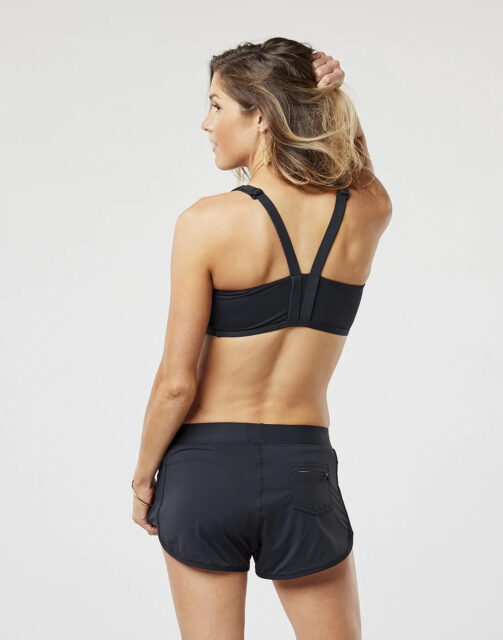
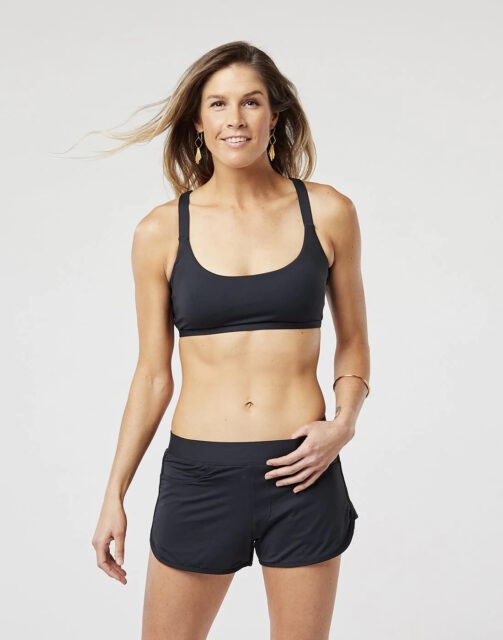
Patagonia Men’s Endless Run Shorts
MSRP: $89
Size Tested: Medium
Matt Mitchell: When I used to do more road running, half-tights were my short of choice for just about every run. Not that their streamlined fit actually had any impact on my speed, but I definitely felt a bit more spry wearing them. Running, after all, is mostly mental, so any perceived edge I could glean from tight-fitting clothing was welcomed. However, when I began to lean more heavily into trail running, I found that most half-tights lacked the storage I needed to support my activities, which on the whole tended to be a lot longer timewise than my typical road run.
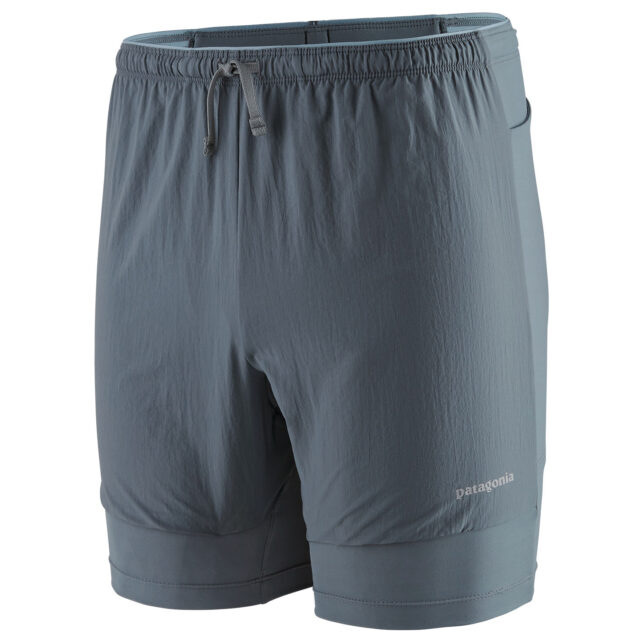
It was apt, then, that the first pair of trail-specific half-tights to win me over were Patagonia’s Endless Run Shorts, though “Shorts” may be a bit of a misnomer here. The Endless Run Shorts fit and feel closer to the half-tights I’m used to, sharing the same form-fitting rear panel and tapered thigh that help keep Patagonia’s recycled nylon close to the skin. Where they differ is in the front, where a thinner nylon panel sits loosely to help keep that very important area ventilated. I’ve heard the Endless Runs affectionately referred to as “pantaloons,” and despite my attempts to rescue them from that gaudy comparison, it’s accurate, from a looks perspective at least. Despite maybe not being the most fashion-forward garment I’ve worn, the Endless Run Shorts might be the most comfortable. I’ve spent several straight days running in them and their ability to moderate temperature and stay in place continues to impress.
As I mentioned earlier, one of the limiting factors preventing me from wearing half-tights on trails is a scarcity of storage for longer efforts. Patagonia designed their Endless Run Shorts to fit into their integrated system for mountain running, and to that effect, they’re consciously constructed with enough space to stash anything you might need for an all-day push. Deep holster pockets roomy enough to accommodate a phone or a soft-flask sit on both sides of the hip for easy accessibility, and a squared back pocket helps to redistribute load for those extra long missions.
The short’s 6-inch inseam also offers a nice compromise between protection and mobility — for my 5’9 frame, a men’s size medium extends to my mid-thigh, a length that never feels too restrictive or skimpy. So, if you’re like me and share a fondness for half-tights (and maybe a heedlessness towards style), but find that most lack the storage needed for trail running, I highly recommend checking out Patagonia’s Endless Run Shorts.
Simms Bugstopper Hoody
MSRP: $84.95
Luke Koppa: The mosquitos finally made their annual debut in Colorado a few weeks ago, and per usual, they can be pretty brutal at times. On a recent weekend float trip, which offered plenty of both sun and bugs, the Simms Bugstopper Hoody did an excellent job of protecting me from both. Its Insect-Shield-treated fabric proved impressively effective at keeping the skeeters from munching on my upper body, and on our float out, the contrast between all my friends’ thoroughly devoured backs and the distinct lack of itchiness on mine was strong evidence of that. In the heat of the day, I appreciated the loose fit and fairly breathable fabric of the hoody, especially since I had to keep it on all day after foolishly thinking I could get away with going shirtless the day before and having the bright-red shoulders to show for it. I now wish that more mountain bike apparel was available with the Insect Shield treatment; swarms of mosquitoes immediately surround me as soon as I stop to snap a photo on the trails, and the aftermarket permethrin treatment doesn’t last nearly as long as the factory-applied Insect Shield version. Maybe we’ll see Insect Shield MTB apparel in the future?
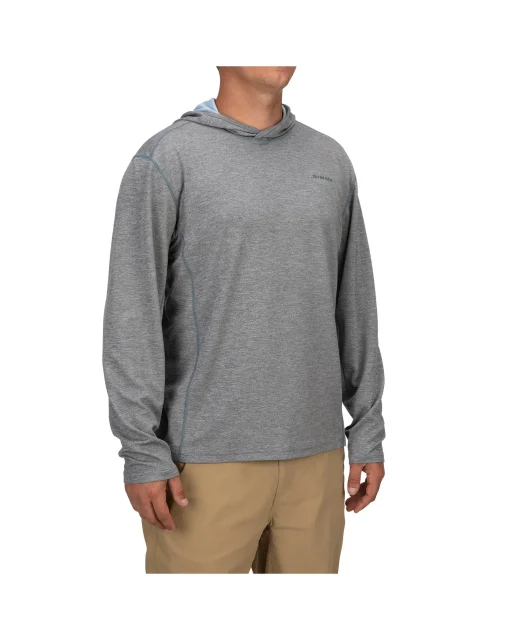
Glade Apres Sunglasses
MSRP: $99
Luke Koppa: Back at the 2022 Blister Summit, Glade’s head of product and sustainability, Michael Barker, was wearing a pair of circular-lens sunglasses that caught my eye. And in the Blister Summit Brand Lineup video I recorded with him, he included a little teaser about what they were — one model in Glade’s first line of sunglasses.
I’ve now used the Glade Apres sunglasses for a few weeks, and I’m a fan for a few reasons. First, I just really like the feel of the (made in Italy) Matte Tortoise frame I have, which is made of 58% bio-based Grilamid. Second, the polarized brown lenses do a great job of not only brightening up the blooming summer greenery, but they’ve also done a good job of cutting through the water of the lakes and rivers around CB while I’m out fishing.
The other main thing to note with the Apres is that it’s a pretty large frame; I have a rather large head / face, so that’s appreciated. I also like that, for how nice the optics and overall build quality is, the Apres comes in at a much more reasonable price point than many other made-in-Italy frames.
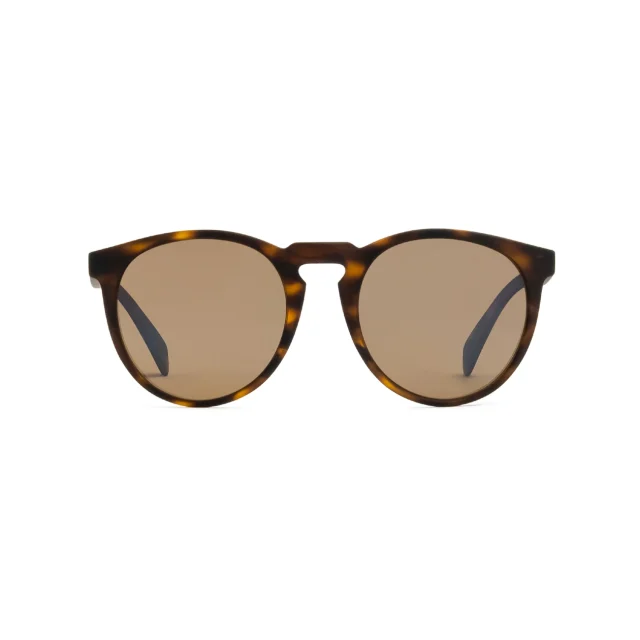
Hario “Skerton Pro” Ceramic Coffee Mill
MSRP: $57.50
Matt Michell: I’ve been living out of my truck for the past couple of weeks, bouncing back and forth between the Eastern Sierra and Tahoe to cover some trail races and get in a handful of bigger days in the mountains myself. Sleep quality in the bed of a Tacoma isn’t always the soundest, and paired with my increased training load, it’s no surprise I’ve been feeling pretty worn down. Inundating myself with a small pond’s worth of coffee every morning seems to be doing a pretty good job keeping me upright though, and I owe a lot of my ability to brew a pot out of the back of my truck to Hario’s Skerton Pro Ceramic Coffee Mill.
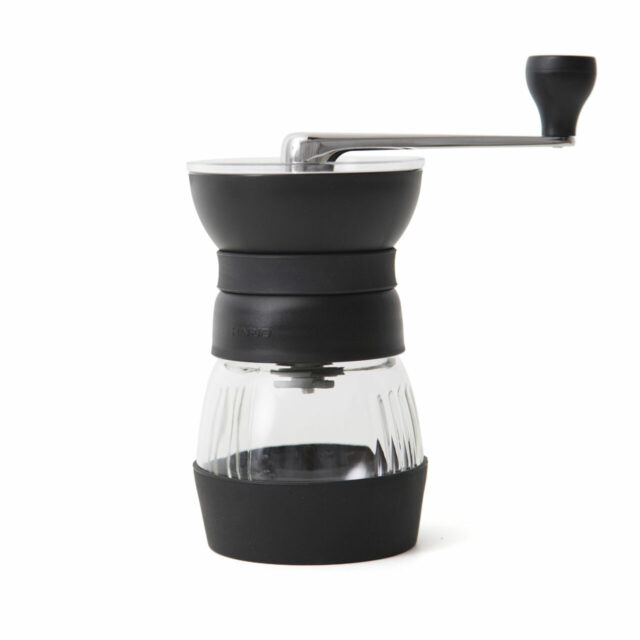
I’ve had this portable hand-grinder since college and still prefer it over most electric ones. Manually processing beans requires a bit more work than plugging something into a wall, but grinding coffee this way generally results in a more consistent grain (which my barista friends tell me is a good thing). The Skerton Pro uses conical burrs made of ceramic to shave coffee beans instead of coarsely crushing them like most blade grinders do. The burr setting is also adjustable and can be tuned to the specifications of your brew method (e.g., a less fine grind for a French press, a finer grind for espresso). Using Hario’s grinder is exceedingly simple, too. Beans are poured into the mouth of the Skerton Pro around an aluminum handle attached to the mill. When the handle is rotated clockwise, the ceramic burrs turn and the grinding process begins. A heat-proof glass bowl screws onto the bottom of the mill to capture the freshly ground coffee. If my arm’s in good shape, I can process a cup’s worth of beans in about 90 seconds — not bad for a hand-grinder that stands just 7.7 inches tall.
I’m admittedly a bit of a self-loathing coffee snob who cares about things like grind size and texture, so having access to professional-grade equipment like the Skerton Pro in the backcountry feels like quite the luxury. Hario approaches their coffeeware with a minimalist design philosophy, and as a result, their products tend to be incredibly durable and easy to use. My Skerton Pro is nearing 8 years of daily use and shows no signs of slowing down.
Fox 36/38 XL Mudguard
MSRP: $25
David Golay: Bolt-on fenders are (finally) becoming commonplace on mountain bike forks, and the new XL version of Fox’s offering for their 36 and 38 is the best one I’ve tried. (There’s also a very similar version for the 40 that seems like it should also be great, but I’ve yet to test it.)
The fender fits the 2021+ versions of the 36 and 38 that have the provision for lower leg bleeder valves on the back of the fork; installing it does require removing and re-installing the valves (or the plugs that take their place on Performance versions of the forks) to sandwich the fender behind them, but it only takes a few minutes and the fender is held super securely once it’s all buttoned up. What really sets the XL version of the fender apart is its coverage — it’s way bigger and substantially more effective than the smaller standard version that Fox offers, or the ones offered by RockShox. The Manitou Mezzer fender is somewhere in between in terms of size and effectiveness, but it isn’t quite stiff enough and can flop around and make some noise.
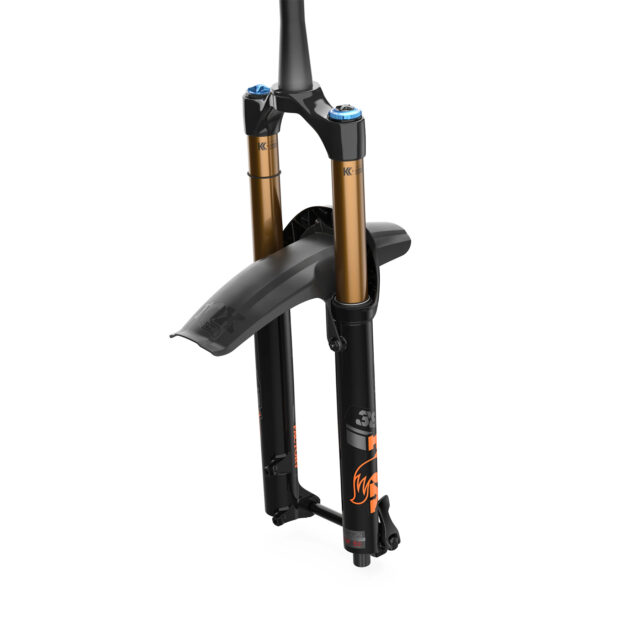
The Fox XL, though, has all that stuff dialed. It’s low-profile in terms of hugging tight to the tire, but still has huge coverage; it’s stiff enough to not flap around noticeably; and it doesn’t weigh much. The Fox XL is way more effective and cleaner looking than the standard zip tied fenders that we all had to resort to until bolt-on versions hit the market, and it doesn’t cost all that much more either.
Dharco SS Jersey
MSRP: $62
Luke Koppa: The bike park at Mt. Crested Butte just opened, which means I’m gonna be spending a fair bit of time there. And if I’m doing that, I’m probably gonna crash at some point. But I’m also going to be baking in the sun between laps. What all that means is that I’m in need of some fairly burly, yet breathable apparel.
To be honest, Dharco’s Short Sleeve Jersey caught my eye mostly because of its colorful tye dye graphics. Off the bike, I’m typically in white, black, or any other subdued colors. On the bike, though, I’m more inclined to go with something brighter, mostly because I spend a lot of time shooting photos of people on bikes and a bright top goes a long way when shooting in dark forests.
Anyway, the Dharco SS Jersey has worked quite well so far. I like its fairly relaxed, long fit; I appreciate its little zippered key / card pocket; and I think it breathes very well for how rugged its thick fabric feels. My only gripe is that, being a fully synthetic piece with no odor-resistant treatment, it starts to stink very quickly. When I’m pedaling in it, I feel a little gross if I wear it for more than one sweaty outing, which definitely limits its usability when trying to get out for several rides each week. That said, I suspect it’s going to hold up much better to the occasional slide in the dirt than my thinner, more odor-resistant merino wool jerseys, and I think it’ll make for a great bike-park jersey (as will the ¾-sleeve version, which I’ve also been using).
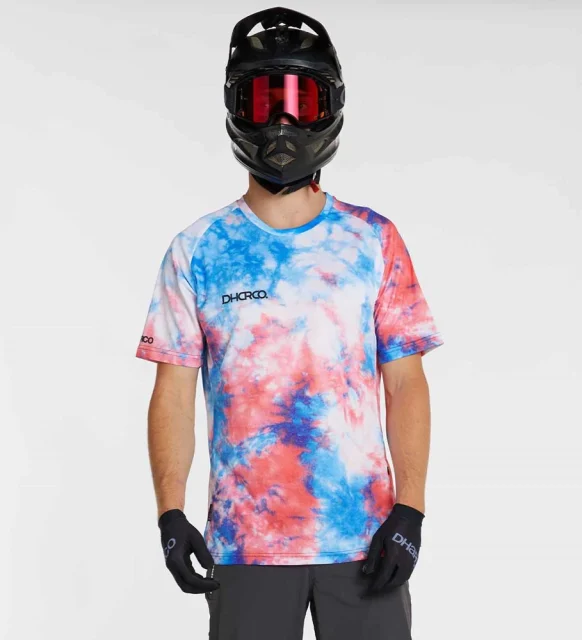
Orvis Recon Fly Rod
MSRP: $598
Jed Doane: I’ve been fly fishing for most of my life and have generally used budget rods as my daily drivers, though I’ve tried $1,000+ rods in the past and definitely noticed a difference in action and accuracy. Seeing as a fly rod is a decades-long investment, with most top brands offering 20+ year warranties on their higher-end rods, I saw Orvis’s Recon line as a big step up without the price tag.
After several months of fishing for trout in the Northwest and a month of hunting steelhead in Alaska, I’m thoroughly impressed by the Recon’s quality. The action is fast and smooth, casts are longer, and I’m catching more fish. The Recon is also noticeably lighter and has better dampening than my previous rods, which made for longer days on the water.

My only minor gripe is the lack of a hook keeper above the grip, which can be easily remedied by adding your own. For the price, the American-made Recon has many of the features of higher-end rods, including the same construction as Orvis’s top-of-the-line Helios series, a grip and reel seat, smooth and durable eyelets, and (for what it’s worth) a nifty matte blue or green look. The 25-year warranty is also an incredible value. For those looking for a fly rod upgrade without the top-of-the-line price tag, the Recon is worth a look.
Air-Lock Strike Indicators
MSRP: $7.99 for 3-pack
Luke Koppa: Fishing this spring has been tricky, but one upside has been that I finally upgraded my strike indicators, and I love Air-Lock’s version. I had always just used the traditional plastic indicators (or, let’s be real: “bobbers”) that required looping the leader around them to secure them in place, and consequently created a bit of a kink in the line. While that didn’t bother me too much, it never felt or looked great.
Air-Lock’s version uses a screw-on attachment with a slot for the leader, so that you don’t need to put a kink in the line to get a secure attachment. And it works great. One word of advice: don’t feel the need to really crank down on the washer; it doesn’t take a ton of pressure to keep the indicator from moving up and down the leader. I am curious to try the Oros screw-on indicators, since they run the line through the center of the indicator for potentially better casting performance and fewer small parts to manage, but I’m currently a big proponent of the Air-Lock ones.


Reviewers – any favorite systems for purifying *snow* as drinking water?
Hi Dan, This is not official Wilderness Med advice but in general, I consider clean, winter snow as safe to drink and have spent cumulative months of my life drinking melted snow on various glacier and other types of trips with no additional purification. If you’re uncomfortable with that or prefer a larger margin of safety from waterborne disease, I’d go one of two routes: If you’re melting snow with a stove, just leave it on long enough to purify by boiling. If you’re letting it passively melt and still want to treat, just treat however you’d normally do it once it’s melted. For weight and reliability my preference if Chlorine Dioxide solution for extended wilderness trips.